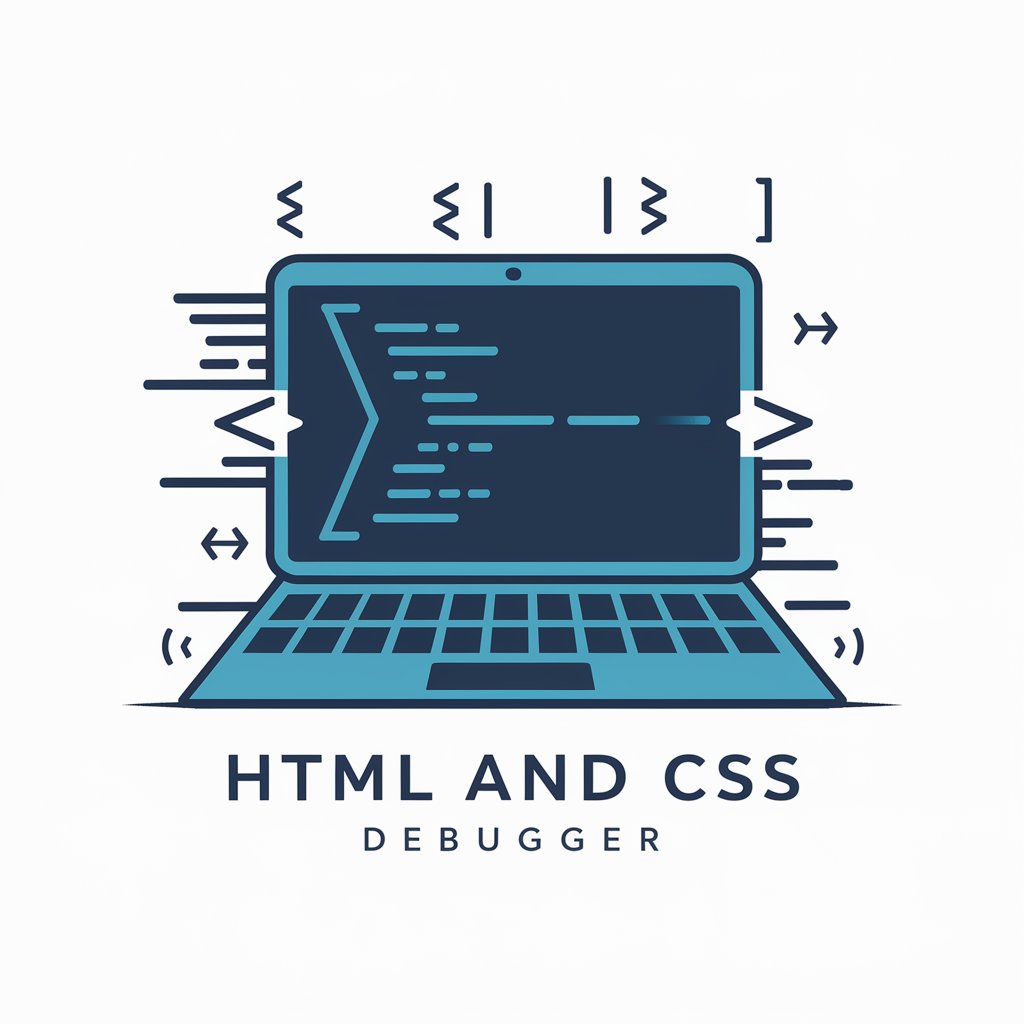HTML and CSS Debugger - HTML/CSS Code Debugging

Hello! How can I assist you with your HTML and CSS today?
Streamlining Web Development with AI
How can I fix the alignment issue in my CSS layout?
What is causing my HTML form to not submit correctly?
Can you help me debug this CSS selector?
Why isn't my HTML image displaying properly?
Get Embed Code
Overview of HTML and CSS Debugger
HTML and CSS Debugger is a specialized tool designed to assist in identifying and resolving issues in HTML and CSS code. It focuses on debugging, offering solutions and explanations to improve web development projects. This tool is crucial for ensuring that web pages are rendered correctly across different browsers and devices. For example, if a user encounters a layout issue in their webpage, the HTML and CSS Debugger can analyze the code, pinpoint the problem, such as incorrect CSS property usage, and provide a solution. Powered by ChatGPT-4o。

Core Functions of HTML and CSS Debugger
Syntax Error Identification
Example
Detecting missing semicolons in CSS.
Scenario
A user writes CSS code but the styles are not applied due to a missing semicolon. The debugger identifies this syntax error, enabling the user to correct it.
Layout Debugging
Example
Resolving issues with flexbox or grid layouts.
Scenario
A web developer struggles with a misaligned flexbox layout. The debugger analyzes the flex properties and suggests corrections to achieve the desired layout.
Cross-Browser Compatibility Checks
Example
Identifying CSS properties that are not supported in certain browsers.
Scenario
A webpage looks different in Internet Explorer. The debugger finds CSS properties that IE doesn't support and suggests alternatives or polyfills.
Responsive Design Testing
Example
Adjusting CSS for various screen sizes.
Scenario
A site doesn't render well on mobile devices. The debugger reviews media queries and viewport settings, offering solutions for a responsive design.
Performance Optimization
Example
Optimizing CSS for faster loading times.
Scenario
A website loads slowly due to bulky CSS. The debugger identifies inefficient selectors and heavy styles, suggesting optimizations for better performance.
Target User Groups for HTML and CSS Debugger
Web Developers
Professionals and hobbyists creating websites. They benefit from efficient debugging to ensure their sites are functional, responsive, and aesthetically pleasing across all platforms.
UI/UX Designers
Individuals focused on the visual and interactive elements of websites. They use the debugger to ensure their designs are correctly implemented in the code.
Students and Educators
Learners and teachers in web development courses. The debugger serves as an educational tool to understand common HTML/CSS pitfalls and best practices.
Freelancers
Independent developers who need to quickly identify and fix issues in their projects. The debugger helps them maintain high-quality work while managing multiple projects.

How to Use HTML and CSS Debugger
Start Your Free Trial
Visit a designated platform offering HTML and CSS debugging tools for a free trial, accessible without the need for login or a premium subscription.
Input Your Code
Copy and paste your HTML and CSS code into the provided text area or upload your code files directly into the tool.
Analyze and Debug
Use the 'Analyze' or 'Debug' button to initiate the code inspection process. The tool will scan for errors, inconsistencies, or areas for optimization.
Review Suggestions
Examine the feedback provided by the debugger, which includes error identifications, warnings, and suggestions for improvements.
Apply Fixes
Adjust your code based on the recommendations. You can re-run the analysis as needed to ensure all issues are resolved.
Try other advanced and practical GPTs
Daily AI News
Stay Ahead with AI-Powered News

Ancestry - Find My Chinese Ancestors
Unlocking your Chinese heritage with AI

Quality Assurance GPT
Automating QA with AI precision

The Valley Song (Sing Of Your Mercy) meaning?
Unraveling the Depths of Music with AI

Creative Connoisseur
Unleash Your Story's Potential with AI

Caption Crafter Pro
Crafting Captions with AI Precision

Mock Interview Mentor
Ace Your Interviews with AI-Powered Coaching

DSA Code Coach
Empowering coders with AI-driven DSA insights.

GenZ Ad Copy Assistant
Crafting trendy ads with AI power

Hi, I'm Jesus
Empowering insights with AI-powered empathy

DMV Tutor
Ace Your DMV Test with AI

Melody Maven
Discover Music, Tailored Just for You

HTML and CSS Debugger FAQs
What types of errors can HTML and CSS Debugger identify?
It can spot syntax errors, missing semicolons, undeclared variables, and compatibility issues across different browsers, among other common coding pitfalls.
Can it help with responsive design testing?
Yes, the debugger can simulate various screen sizes and devices, helping you ensure your website's design is responsive and functions well on all platforms.
Does the tool offer suggestions for code optimization?
Absolutely, it provides actionable advice on how to make your code more efficient, such as reducing redundancy and improving load times.
Is there support for modern CSS frameworks?
Yes, it supports analysis of code using modern CSS frameworks like Bootstrap, Tailwind, and others, identifying misuse or potential improvements.
How does the tool handle privacy and security of uploaded code?
The tool employs strict data protection measures, ensuring that your code remains private and is not stored longer than necessary for the debugging process.
